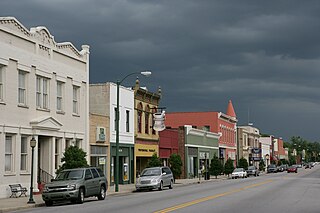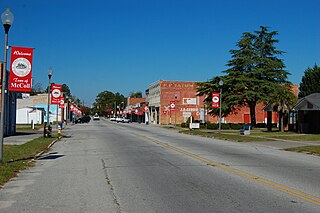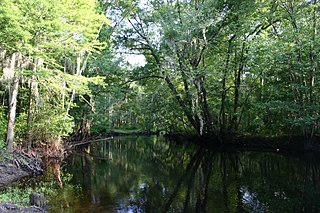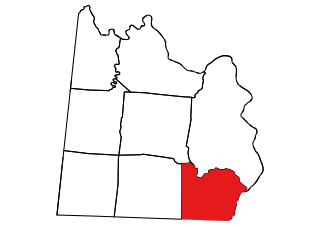Related Research Articles

Marion is a city in and the county seat of Marion County, South Carolina, United States. It is named for Francis Marion, a brigadier general from South Carolina in the American Revolutionary War. The population was 6,939 at the 2010 census.

McColl is a town in Marlboro County, South Carolina, United States. It lies in the state's Pee Dee region, 8 miles (13 km) from the North Carolina border. The population was 2,174 at the 2010 census.

The Little Pee Dee River is a 116-mile-long (187 km) tributary of the Pee Dee River. The Little Pee Dee technically arises near Laurinburg, North Carolina as Gum Swamp, which flows southward, receiving several small tributaries, across the South Carolina border into Red Bluff Lake, near McColl, South Carolina. The lake is at an elevation of 135 feet (41 m) above sea level, and from the outlet of the lake, the flow is called the Little Pee Dee River. The Little Pee Dee River is named after the Pee Dee Indian Tribe. Today, the tribe still occupies some of the land, although the tribe only consists of just over 200 enrolled members.
The Pee Dee is a region in the northeast corner of the U.S. state of South Carolina. It lies along the lower watershed of the Pee Dee River, which was named after the Pee Dee, an Indigenous tribe historically inhabiting the region.

The Tennessee–Tombigbee Waterway is a 234-mile (377 km) artificial U.S. waterway built in the 20th century from the Tennessee River to the junction of the Black Warrior-Tombigbee River system near Demopolis, Alabama. The Tennessee–Tombigbee Waterway links commercial navigation from the nation's midsection to the Gulf of Mexico. The major features of the waterway are 234 miles (377 km) of navigation channels, a 175-foot-deep (53 m) cut between the watersheds of the Tombigbee and Tennessee rivers, and ten locks and dams. The locks are 9 by 110 by 600 feet, the same dimension as those on the Mississippi above Lock and Dam 26 at Alton, Illinois. Under construction for 12 years by the U.S. Army Corps of Engineers, the Tennessee–Tombigbee Waterway was completed in December 1984 at a total cost of nearly $2 billion.

The Lumber River, sometimes referred to as the Lumbee River, is a 133-mile-long (214 km) river in south-central North Carolina in the flat Coastal Plain. European settlers first called the river Drowning Creek, which is still used as the name of its headwater. The waterway known as the Lumber River extends downstream from the Scotland County-Hoke County border to the North Carolina-South Carolina border. Soon after crossing into South Carolina, the Lumber River flows into the Little Pee Dee River, which flows into the Pee Dee River, or Great Pee Dee River. Finally, the combined waters flow into Winyah Bay and the Atlantic Ocean.

Town Creek Indian Mound is a prehistoric Native American archaeological site located near present-day Mount Gilead, Montgomery County, North Carolina, in the United States. The site, whose main features are a platform mound with a surrounding village and wooden defensive palisade, was built by the Pee Dee, a South Appalachian Mississippian culture people that developed in the region as early as 980 CE. They thrived in the Pee Dee River region of North and South Carolina during the Pre-Columbian era. The Town Creek site was an important ceremonial site occupied from about 1150—1400 CE. It was abandoned for unknown reasons. It is the only ceremonial mound and village center of the Pee Dee located within North Carolina.
Old Town was a Chickasaw village in northeast Mississippi in present-day Lee County.
Pee Dee is an unincorporated community in southwestern Montgomery County, North Carolina, United States, located on North Carolina Highway 73. U.S. Representative and State Senator Edmund Deberry lived in Pee Dee, which was a township at that time, until his death in 1859.
Pee Dee Creek is a stream in Marion and Shelby counties in the U.S. state of Missouri. It is a tributary to the South Fork of the North River.
Jones Branch is a stream in the U.S. state of Missouri. It is a tributary of Pee Dee Creek.

Barringer Township is a non-functioning township in Iredell County, North Carolina, United States. By the requirements of the North Carolina Constitution of 1868, the counties were divided into townships, including sixteen in Iredell County.
Boguefala Creek is a stream in the U.S. state of Mississippi.
Boguegaba Creek is a stream in the U.S. state of Mississippi.
Chiwapa Creek is a stream in the U.S. state of Mississippi. It is a tributary to Town Creek.
Chiwapa is an unincorporated community in Pontotoc County, in the U.S. state of Mississippi.
Chuquatonchee Creek is a stream in Chickasaw, Clay and Pontotoc counties in the U.S. state of Mississippi. It is a tributary to Tibbee Creek.
Coonewah Creek is a stream in the U.S. state of Mississippi. It is a tributary to Town Creek.

Lilesville Township, population 3,366, is one of eight townships in Anson County, North Carolina, United States. Lilesville Township is 108.02 square miles (279.8 km2) in size, and is located in northeastern Anson County. Lilesville Township contains the town of Lilesville.

Morven Township, population 2,065, is one of eight townships in Anson County, North Carolina, United States. Morven Township is 48.39 square miles (125.3 km2) in size and located in southeastern Anson County. Morven Township contains the towns of Morven and McFarlan within it.
References
- ↑ U.S. Geological Survey Geographic Names Information System: Pee Dee Creek (Mississippi)
- ↑ Baca, Keith A. (2007). Native American Place Names in Mississippi. University Press of Mississippi. p. 81. ISBN 978-1-60473-483-6.
34°32′31″N88°24′11″W / 34.5420418°N 88.4031033°W